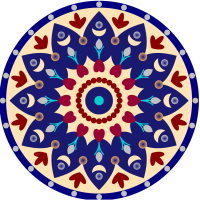Chimaji Appa
Regular Member
- Joined
- Apr 10, 2020
- Messages
- 243
- Likes
- 634
When a tiny hill kingdom defeated the most powerful army in Asia.
Garwhal was a tiny hill state located in the lower Himalayas, and was ruled by the Pal Dynasty (an offshoot of the Paramaras). The Hill States, despite being so low in number of troops and cavalry, always used successful guerrilla tactics to nearly wipe out armies that were much larger than it, as seen in the failed Qarachil expedition launched by Muhammad Bin Tuglaq. In 1634, the Faujduar of Kangra, Najabat Khan received permission to invade the neighboring Garhwal kingdom. The size of the army was listed as 130,000 by Nicolas Mannuci and 100,000 by Travenier, but a reasonable estimate would be somewhere around 25,000-30,000, while the Garhwal kingdom could reasonably only field 3,000-5,000 (1,000 is given by travenier). Upon Najabat Khan's arrival, the Queen of Garhwal is said to have lured the army in the hills by lying about giving 1 million rupees in tribute. The Garhwali forces, after constantly harrasing the Mughals, closed the retreats and exits, then destroyed the Mughal Army down to a man. The Mughal forces were severly defeated and retreated back to Kangra. This is the account given by the Maasir Ul Umara, while Manucci gives somewhat of a different account and claims that the survivors' noses were actually cut off, hence earning the Queen of Garhwal (Rani Karnavati) the title "Nak-kati-Rani" (Nak Kati means noses cut). John F Richards also mentions this battle in his "The Mughal Empire" book, where he states that "so badly were the Mughals mauled that they did not attack for another 20 years".
Whatever the case may be, this was one of the greatest military achievments of Uttarakhand and the Himalayan States. It should also be noted that the Mughal army wasn't some unoperational army who never fought in the hills, they were campaigning in places like Kandhar in Afghansitan, leading successful campaigns into the Deccan, and even fought and achieved success against the Ladakhis.
My sources:
Maasir Ul Umara
Storia de Mogor by Nicolas Mannuci
Garhwal Himalayas: A Study in Historical Perspective by Ajay Singh Rawat
The Mughal Empire by John F Richards
Hitsory of Shah Jahan of Dihli by BP Sakasena
You can check out the rest of my blog down below. I will be updating it every week at least once with different conflicts and Islamic invasions.
 uttaranachalhistory.blogspot.com
uttaranachalhistory.blogspot.com
Garwhal was a tiny hill state located in the lower Himalayas, and was ruled by the Pal Dynasty (an offshoot of the Paramaras). The Hill States, despite being so low in number of troops and cavalry, always used successful guerrilla tactics to nearly wipe out armies that were much larger than it, as seen in the failed Qarachil expedition launched by Muhammad Bin Tuglaq. In 1634, the Faujduar of Kangra, Najabat Khan received permission to invade the neighboring Garhwal kingdom. The size of the army was listed as 130,000 by Nicolas Mannuci and 100,000 by Travenier, but a reasonable estimate would be somewhere around 25,000-30,000, while the Garhwal kingdom could reasonably only field 3,000-5,000 (1,000 is given by travenier). Upon Najabat Khan's arrival, the Queen of Garhwal is said to have lured the army in the hills by lying about giving 1 million rupees in tribute. The Garhwali forces, after constantly harrasing the Mughals, closed the retreats and exits, then destroyed the Mughal Army down to a man. The Mughal forces were severly defeated and retreated back to Kangra. This is the account given by the Maasir Ul Umara, while Manucci gives somewhat of a different account and claims that the survivors' noses were actually cut off, hence earning the Queen of Garhwal (Rani Karnavati) the title "Nak-kati-Rani" (Nak Kati means noses cut). John F Richards also mentions this battle in his "The Mughal Empire" book, where he states that "so badly were the Mughals mauled that they did not attack for another 20 years".
Whatever the case may be, this was one of the greatest military achievments of Uttarakhand and the Himalayan States. It should also be noted that the Mughal army wasn't some unoperational army who never fought in the hills, they were campaigning in places like Kandhar in Afghansitan, leading successful campaigns into the Deccan, and even fought and achieved success against the Ladakhis.
My sources:
Maasir Ul Umara
Storia de Mogor by Nicolas Mannuci
Garhwal Himalayas: A Study in Historical Perspective by Ajay Singh Rawat
The Mughal Empire by John F Richards
Hitsory of Shah Jahan of Dihli by BP Sakasena
You can check out the rest of my blog down below. I will be updating it every week at least once with different conflicts and Islamic invasions.
Military of the Himalayan States as well as India.
Last edited by a moderator:


